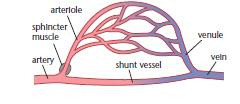Blood vessels
After studying this section you should be able to:
• describe the structure and functions of arteries, capillaries and veins
• understand the importance of valves in the return of blood to the heart
• understand the difference between plasma, tissue fluid and lymph
Arteries, veins and capillaries
The blood is transported to the tissues via the vessels. The main propulsion is by the ventricular contractions. Blood leaves the heart via the arteries, reaches the tissues via the capillaries, then returns to the heart via the veins. Each blood vessel has a space through which the blood passes; this is the lumen. The structure of the vessels is shown below.
Artery
• It has a thick tunica externa which is an outer covering of tough collagen fibres.

• It has a tunica media which is a middle layer of smooth muscle and elastic fibres.
• It has a lining of squamous endothelium (very thin cells).
• It can contract using its thick muscular layer.
Capillary
• It is a very thin blood vessel, the endothelium is just one cell thick.
• Substances can exchange easily.
• It has such a high resistance to blood flow that blood is slowed down. This gives more time for efficient exchange of chemicals at the tissues.
Vein

• It has a thin tunica externa which is an outer covering of tough collagen fibres.
• It has a very thin tunica media which is a middle layer of smooth muscle and elastic fibres.
• It has a lining of squamous endothelium (very thin cells).
• It is lined with semi-lunar valves which prevent the backflow of blood.
Note that the pressure in the arteries is highest because:
(a) they are closest to the ventricles
(b) they contract forcefully themselves.
Capillaries are the next highest in pressure, the main factor being their resistance to blood flow. Finally, the pressure of veins is the lowest because:
(a) they are furthest from the ventricles
(b) they have a low amount of muscle.
If given blood pressures of vessels, be ready to predict the correct direction of blood flow.
How do the veins return the blood to the heart?
Veins have a thin tunica media, so only mild contractions are possible. They return blood in an unexpected way. Every time the organism moves physically, blood is squeezed between skeletal muscles and forced along the vein.
KEY POINT - Blood must travel towards the heart because of the direction of the semi-lunar valves. Any attempt at backflow and the semi-lunar valves shut tightly!
Capillary network
Every living cell needs to be close to a capillary. The arteries transport blood from the heart but before entry into the capillaries it needs to pass through smaller vessels called arterioles. Many arterioles contain a ring of muscle known as a pre-capillary sphincter. When this is contracted the constriction shuts off blood flow to the capillaries, but when it is dilated, blood passes through. Some capillary networks have a shunt vessel. When the sphincter is constricted blood is diverted along the shunt vessel so the capillary network is by-passed. After the capillary network has permeated an organ the capillaries link into a venule which joins a vein.

Although the pressure of the blood in the capillaries is lower than in the arteries or arterioles, there is still enough pressure to force out some of the liquid part of the blood. The liquid part of the blood is called plasma and when it is forced out of the capillaries it is called tissue fluid. This tissue fluid bathes the cells, supplying them with nutrients and taking up waste products. At the venous end of the capillary bed, most of this tissue fluid is reabsorbed back into the capillaries.
Note that In the skin the superficial capillaries have the arteriole/shunt vessel/venule arrangement as shown above. When the arteriole is dilated (vasodilation) more heat can be lost from the skin. When the arteriole is constricted (vasoconstriction) the blood cannot enter the capillary network so is diverted to the core of the body. Less heat is lost from the skin.
Lymphatic system
There is a network of vessels other than the blood system. They are the lymphatic vessels. They collect any tissue fluid that is not reabsorbed back into the capillaries. The lymph vessels have valves to ensure transport is in one direction. Along some parts of the lymphatic system are lymph nodes. These are swellings lined with white blood cells (macrophages and lymphocyte cells). The lymph fluid is finally emptied back into the blood near the heart.
PROGRESS CHECK
(a) (i) Which type of vessel, artery, vein or capillary is shown? Give a reason for your choice.

(ii) What is the function of the tunica media?
(b) The pressure values 30 kPa, 10 kPa and 5 kPa correspond to the different types of vessel.
Give the correct value for each vessel so that blood flows around the body.
(a) (i) artery; the vessel has a thick tunica externa
(ii) contracts to help transport blood.
(b) artery, 30 kPa, capillary, 10 kPa and vein, 5 kPa.
